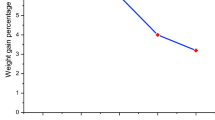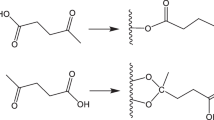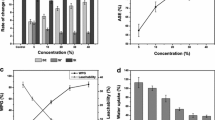Abstract
Wood, one of the flammable material, was treated with aqueous solution of guanidine nitrate (GUN) and also with small amount of bases like N,N-dimethylformamide, 4-dimethylaminopyridine, pyridine, and triethylamine in the treating solution. These bases catalyze the impregnation of GUN as indicated by increase in mass gain percentage, elemental analysis, and scanning electron microscopy. To study their thermal behavior, dynamic thermogravimetry (TG) and derivative thermogravimetry (DTG) analysis under nitrogen atmosphere have been applied from ambient temperature to 973 K on all samples, at multiple linear heating rates 2.5, 5, 10, and 20 K min−1. Non-isothermal, “model free” iso-conversional multiple heating rate methods, Ozawa–Flynn–Wall (O–F–W) and modified Coats–Redfern are used to calculate activation energy of samples. The activation energy of samples is found in the range 109–208 kJ mol−1. Thermal parameters like overall pyrolysis duration, maximum mass loss rate, corresponding to DTG peak maximum and percentage char yield calculated at 873 K from TG curves are used to appraise the flammability of samples. Also, flammability of samples is determined by reliable methods namely limiting oxygen index and underwriters laboratories 94 (UL 94) test. The aforesaid study indicates that base catalyzed impregnated samples are less flammable than those impregnated with only GUN and untreated ones.










Similar content being viewed by others
References
Horvath AL. Solubility of structurally complicated materials: I wood. J Phys Chem Ref Data. 2006;35:77–92.
Kandola BK, Horrocks AR, Price D, Coleman GV. Flame retardant treatments on cellulose and their influence on the mechanism of cellulose pyrolysis. Polym Rev. 1996;36:721–94.
Summary fire statistics, United Kingdom, 2006. http://www.communities.gov.uk. 2008.
Gao M, Sun CY, Wang CX. Thermal degradation of wood treated with flame retardants. J Therm Anal Calorim. 2006;85:765–9.
Blasi CD, Branca C, Galgano A. Thermal and catalytic decomposition of wood impregnated with sulphur-and phosphorous-containing ammonium salts. Polym Degrad Stab. 2008;93:335–46.
Luneva NK, Petrovskaya LI. Performance of intumescent fire retardant for wood. Russ J Appl Chem. 2008;81:704–7.
Liodakis S, Vorisis D, Agiovlasitis IP. Testing the retardancy effect of various inorganic chemicals on smoldering combustion of Pinus halepenis needles. Thermochem Acta. 2006;444:157–65.
Kulakov VA, Zhabankov RG, Yurchenko VM. IR spectroscopic study of cellulose treated by guanidine and urea salt solutions. J Appl Spectrosc. 1987;47:797–801.
Gao M, Sun C, Zhu K. Thermal degradation of wood treated with guanidine compounds in air. J Therm Anal Calorim. 2004;75:221–32.
Gao M, Ling B, Yang SS, Zhao M. Flame retardance of wood treated with guanidine compounds characterized by thermal degradation behavior. J Anal Appl Pyrolysis. 2005;73:151–6.
Ellis WD, Rowell RM, LeVan SL, Susott RA. Thermal degradation properties of wood reacted with diethylchlorophosphate or phenylphosphonic dichloride as potential flame retardants. Wood Fiber Sci. 1987;19:439–45.
Flynn JH, Wall LA. General treatment of thermogravimetry of polymers. J Res Natl Bur Stand Sect A Phys Chem. 1966;A70:487–523.
Ozawa T. A new method of analyzing thermogravimetric data. Bull Chem Soc Jpn. 1965;38:1881–6.
Brown ME, Maciejewski M, Vyazovkin S, Nomen R, Sempere J, Burnham AK, et al. Computational aspects of kinetic analysis. Part A: the ICTAC kinetics project-data, methods and results. Thermochim Acta. 2000;355:125–43.
Yao F, Wu Q, Lei Y, Guo W, Xu Y. Thermal decomposition kinetics of natural fibers: activation energy with dynamic thernogravimetric analysis. Poly Degrad Stab. 2008;93:90–8.
Jain RK, Lal K, Bhatnagar HL. Thermal degradation of cellulose and its phosphorylated products in air and nitrogen. J Appl Polym Sci. 1985;30:897–914.
Antal MJ, Varhegyi G. Cellulose pyrolysis kinetics—the current state knowledge. Ind Eng Chem Res. 1995;34:703–17.
Liodakis S, Antonopoulos I, Kakardakis T. Evaluating the use of minerals as forest fire retardants. Fire Safety J. 2010;45:98–105.
Liodakis S, Kakardakis T, Tzortzakou S, Tsapara V. How to measure the particle ignitability of forest species by TG and LOI. Thermochem Acta. 2008;477:16–20.
Cavallaro G, Donato DI, Lazzara G, Milioto S. A comparative thermogravimetric study of waterlogged archaeological and sound woods. J Therm Anal Calorim. 2011;104:451–7.
Dahiya JB, Kumar K, Muller-Hagedorn M, Bockhorn H. Kinetics of isothermal and non-isothermal degradation of cellulose: model-based and model-free methods. Polym Int. 2008;57:722–9.
Cabrales L, Abidi N. On the thermal degradation of cellulose in cotton fibers. J Therm Anal Calorim. 2010;102:485–91.
Corradini E, Teixeira EM, Paladin PD, Agnelli JA, Silva ORRF, Mattoso LHC. Thermal stability and degradation kinetic study of white and colored cotton fibers by thermogravimetric analysis. J Therm Anal Calorim. 2009;97:415–9.
Lin YC, Cho J, Tompsett GA, Westmoreland PR, Huber GW. Kinetics and mechanism of cellulose pyrolysis. J Phys Chem C. 2009;113:20097–107.
Arora S, Kumar M, Dubey GP. Thermal decomposition kinetics of rice husk: activation energy with dynamic thermogravimetric analysis. J Energy Inst. 2009;82:138–43.
Arora S, Bagoria R, Kumar M. Effect of alpha-tocopherol (vitamin E) on the thermal degradation behaviour of edible oils. J Therm Anal Calorim. 2010;102:375–81.
Acknowledgements
Mahesh Kumar is thankful to Council of Scientific and Industrial Research, New Delhi, India for providing senior research fellowship and Mahender Kumar is grateful to Kurukshetra University, Kurukshetra for awarding university research scholarship. We are also thankful to Vikas Kumar (BARC, Mumbai) and Vinod Kumar (IIT, Delhi) for their support.
Author information
Authors and Affiliations
Corresponding author
Rights and permissions
About this article
Cite this article
Arora, S., Kumar, M. & Kumar, M. Catalytic effect of bases in impregnation of guanidine nitrate on Poplar (Populus) wood. J Therm Anal Calorim 107, 1277–1286 (2012). https://doi.org/10.1007/s10973-011-1779-z
Received:
Accepted:
Published:
Issue Date:
DOI: https://doi.org/10.1007/s10973-011-1779-z




